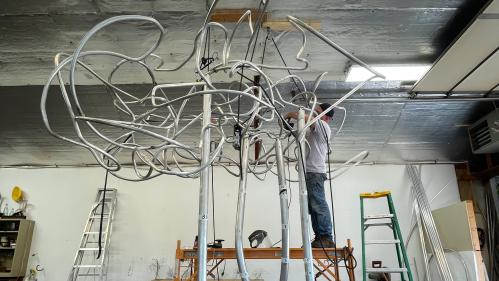Zimmerli Installs Sculpture by Former Mason Gross Professor (Who's Also a Rutgers Alum)

Patrick Strzelec, a Guggenheim fellow and recipient of the Rutgers Presidential Fellowship award for teaching excellence, crafted the work to honor the Class of 1965
Outside of the Zimmerli Art Museum on Rutgers University–New Brunswick’s College Avenue campus stands a new sculpture by Patrick Strzelec, professor emeritus in the Department of Art & Design at the Mason Gross School of the Arts, where he earned his master of fine arts degree in 1987.

Installed at the front terrace of the art museum in August, Past is Prologue is a 13-foot-tall work made of high-grade aluminum. Strzelec, a resident of Bucks County, Pa., who originally hails from Chicago Heights, Ill., crafted the work to honor the Rutgers Class of 1965, which funded the commission.
“Patrick Strzelec has created a beautiful evocation of thought as it rises, twists, turns and expands into a powerful idea,” Donna Gustafson said before her Sept. 1 retirement as the Zimmerli’s chief curator. “Patrick wanted to create an homage to the class that acknowledged the 1960s as a time of tumultuous change. I think he has done so.”
Strzelec, a Guggenheim fellow and a recipient of the Rutgers Presidential Fellowship award for teaching excellence, discusses Past is Prologue as well as his time (2010 to 2021) at Mason Gross and Rutgers.
How do you feel about the Zimmerli installing one of your sculptures on the museum’s terrace?
It is an honor to have made a sculpture in recognition and appreciation of the Class of 1965.
The Zimmerli museum has always been an important part of my pedagogy at Rutgers and to have made a sculpture for a specific concept and place has been an exciting yet humbling experience.

What’s your sculpture about? What does it represent?
The sculpture is a song to 1965 class members. It seeks to reflect their magic, their trajectory, their innocence, the fervor to do right. The sculpture is intended to represent the bending of the circle of history.
The linear cluster is a 240-foot continuous line never intersecting but touching at strategic points, a deconstruction of the circle. The line establishes dialogues of history and individual efforts that, together, create movement and growth. It also captures the importance of gaining insight from the past, especially to avoid repeating detrimental cycles. The aerial structure that explodes into the sky encourages hope and optimism.
What compelled you to sculpt it?
Research into the ’60s with acknowledgment to the Class of 1965.
What drew you to abstract sculpture?
It is a way to depart from reality and explore relationships and concepts sometimes deeper than representation.
As a viewer, what’s a good approach to absorbing and taking in a work of abstract art?
It’s all about giving the work time and putting in the effort to observe and capture the essence of the work.
It is a way to depart from reality and explore relationships and concepts sometimes deeper than representation.
Patrick Strzelec
on what drew him to abstract sculpture
What’s your favorite memory as a Mason Gross art professor?
There are many memories during my tenure, but I have to say the day I was introduced to one of the most outstanding faculties I have ever worked with and meeting my first sculpture class at Rutgers.
What advice do you have for aspiring artists attending Rutgers?
Listen, engage and acquire as much information from the professors at Rutgers as possible. Then go out and change the world.




